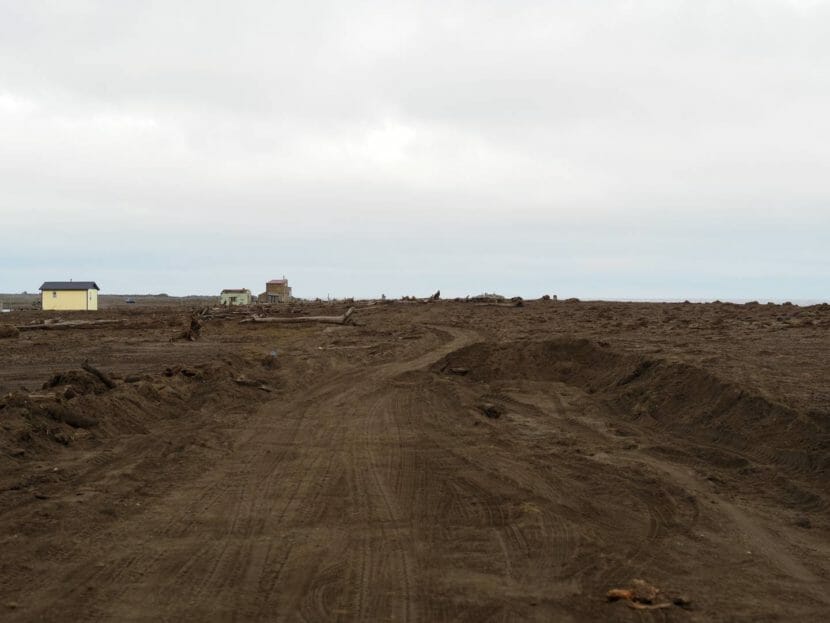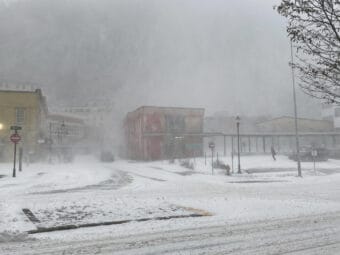
NOME — The storm that slammed Western Alaska over the weekend has reorganized the land.
There was no loss of life, but the landscape of Nome is physically altered for the foreseeable future, with raw material scattered wildly, the coastline reconfigured, the camps and shore-side compounds anchoring generations of subsistence either flattened or gone.
All up and down the Nome-Council Road heading east out of town, cabins used for fishing, foraging and seasonal family life are in ruin.
“Some of them just disappeared,” said Bryant Hammond, the incident commander for Nome’s emergency operation center.
Nome, a city of about 3,700 people that functions as the commercial and logistical hub for 15 smaller communities in the Bering Strait region, weathered the worst storm in decades relatively well. By Monday, business owners were unboarding windows along Front Street and shoveling muck out of gutters as heavy equipment rumbled around side streets and the seawall. Utilities are fine. Many car and truck owners are gradually discovering their vehicles were effectively totaled by partial submersion in the salty, silty floodwaters.
But the worst damage is out of town, with an as-yet-uncounted number of subsistence cabins in shambles.
To those unfamiliar with Western Alaska, the word “cabin” might conjure a hut of neatly notched logs nestled in the woods, or a euphemism for a lavish weekend home overlooking Nancy Lake. These are not those. The fish camps peppering the river mouths and shores of the southern Seward Peninsula are more like cozy shacks, neither electrified nor plumbed, buttressed by meat racks, smokehouses, saunas, cutting tables, woodpiles and utilitarian bric-a-brac for making use of the land and sea’s seasonal offerings.

They are essential to the region’s economy: family-scale food production and processing plants, summertime child care and education centers, a release valve for overcrowded homes and apartments in a region with an endemic housing shortage.
“My daughter’s smokehouse is gone. The outhouses, gone,” said Sterling Gologergen, standing at her second-story living room window, from where she watched the storm drown Nome’s small-boat harbor Saturday.
Even though the main cabin at her daughter’s camp remained intact, bedding and other material inside was soaked, ruined, costly to eventually replace, Gologergen said. Though she’s lived in Nome for a decade, the 67-year-old spent most of her life on St. Lawrence Island, where the communities of Gambell and her hometown of Savoonga were largely spared substantial destruction, but caches of fish and meat stored or hung from racks by the shore were trashed or gone.
“Already a lot of people are out beachcombing for edible stuff,” Gologergen said. “And to see what’s left of everyone’s camps.”
“They work faster than internet,” she said with a laugh about damage assessment and repair work. “The network of people out in the villages. And they already had it done yesterday.”
Camps are less built than accumulated over years and generations, rarely insured or registered in the formal banking system, which makes financing reconstruction or repair all the more difficult.

Gologergen said she worries about the storm’s lasting impact on vegetation. Tufts of sea foam “the size of baseballs” blanketed the street below her window. She fears the ocean salt could wither next summer’s berry crop along the miles and miles of shore.
Ruined, too, is the Nome-Council Road itself. For the first two dozen miles or so, it’s passable, especially since the state Department of Transportation has had graders and heavy equipment removing stones plucked loose from the seawall, fixing washouts, pushing driftwood to the sides and leveling drifted sand.
But then around Mile 24, there’s a massive new hole where the creek-fed Safety Sound punctured the barrier islands that supported the road.
“That lagoon became one with the ocean, where our camps are,” Gologergen said.
Camps on the far side of the new quarter-mile-wide gash are now cut off, except by plane.
“I don’t think if you had a canoe you could get across it,” Hammond said.

Families with seasonal camps past Safety Sound, along with a few dozen old-timers who live most of the year out around Council, will have to find new ways of getting into town.
“We’re gonna have to build a new bridge, looks like,” Hammond said.
The storm was major: high seas, ferocious wind, powerful waves, all of it lasting for well over a day. The massive seawall that helped blunt the damage to town was reordered elsewhere along the coastline. Boulders and rocks are scattered everywhere. Swaths of beach are gone, eroded, as if erased or dropped 6 feet lower than they should be, the sand swept away and sprinkled all over the tundra on the lee side of the road.

There will be major repairs and challenges ahead, not just for Nome but across the region, all the way to the mouth of the Kuskokwim River hundreds of miles south. Even communities that fared relatively well — that didn’t lose whole houses or see major infrastructure fail — will be grappling with considerable costs that are not easily or quickly tallied in the accounting of a cataclysm: family camps, familiar harvesting grounds, small boats and subsistence equipment, rebuilding pummeled weather mitigation infrastructure.
“The system reorganized. It does it normally in nature. But we humans, it kinda screws us,” Hammond said.

In a reordering of the land, for some, there is opportunity. Along the scoured beaches heading east out of Nome, there are newly churned up plumes of red-tinged dirt, the kind known to be fertile hunting grounds for gold. As public employees smoothed the road, volunteers picked up driftwood or detritus, distant figures surveyed cockeyed cabins and a few gold miners with small dredging rigs attached to their pickup trucks panned the freshly pulped beach for treasure.


